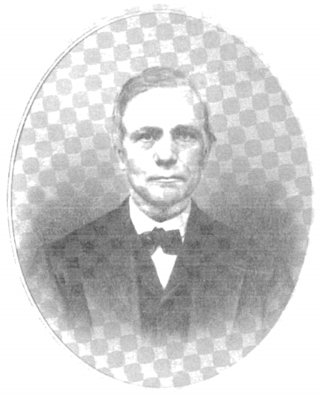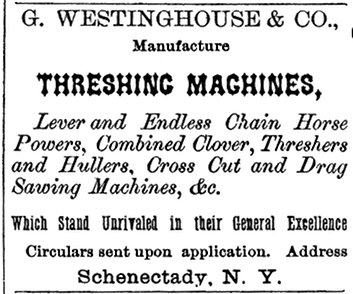
George Westinghouse, Sr., from Life of George Westinghouse [Jr.], by Henry G. Prout
In 1856, farmer and agricultural toolmaker George Westinghouse, Sr. (1809-1884), moved from Central Bridge, NY, to Schenectady to take advantage of the new Erie Canal. He established a new firm, the Schenectady Agricultural Works, G. Westinghouse & Co. The business made agricultural machinery, mill machinery, and small steam engines. In 1865, Westinghouse was granted a sawmill patent. An 1872 ad mentions drag saws as one of their products.

1872 ad from "Boyd's New York State Business Directory and Gazetteer"
George Westinghouse, Sr., was the father of the famous and important inventor, George Westinghouse, Jr., who ultimately held over 400 patents. His first patent, granted in 1865, was for a rotary steam engine that was manufactured by his father's company but was not very successful. George Junior then went out on his own, eventually establishing Westinghouse Electrical Manufacturing Co. in Pittsburgh in 1886. When George Senior died in 1884, control of the by-then successful and prominent G. Westinghouse & Co. passed to his three surviving sons (another son having been killed during the Civil War). His sons were ambitious and aggressively expanded the business, bringing in various cousins and brothers-in-law to keep control within the family. The business survived until at least 1895, but was gone by 1910.
Note: This firm did not manufacture electric motors! Westinghouse electrical products were made by Westinghouse Electrical & Manufacturing Co., a firm started by George Westinghouse Jr., the son of the founder of Westinghouse Co.
Information Sources
-
Life of George Westinghouse, 1921, by Henry G. Prout, says, "In 1856, George Westinghouse, Sr., established in Schenectady a shop for making agricultural machinery, mill machinery, and small steam engines. The shop, bearing the sign "G. Westinghouse & Co.", long stood at the very gate of the great works of the General Electric Company."
- From a web page on the historic houses of Schenectady:
Schenectady's many advantages led machinist George Westinghouse, Sr. to re-locate and enlarge his manufacturing shops to the city from rural Central Bridge (Schoharie County) in 1856. As the "Schenectady Agricultural Works: G. Westinghouse & Co," the firm emerged as a leading manufacturer of farm machinery. At the death of George Westinghouse, Sr. in 1884, ownership of the greatly expanded firm passed to his three sons, among them George Westinghouse, Jr. During the post-Civil War decades, George Westinghouse, Jr. gained international fame and vast wealth from a series of engineering achievements, including the railroad air brake (1869), interlocking railroad signal system (1879) and commercial development of alternating electric current and long-distance power transmission. The Westinghouse Electric Company (established in Pittsburgh, 1886) became the direct competitor of the nascent Edison Electric Company, which Thomas Edison moved to Schenectady in 1887. The struggle for market supremacy between the rival interests was intense and personal; the presence of Westinghouse business interests in Schenectady further increased this tension.
- The 1872 issue of Boyd's New York State Business Directory and Gazetteer carries an ad for G. Westinghouse & Co. The ad mostly features agricultural machinery, but it does mention their drag saws.
- A PSU biography of George Westinghouse, Jr. provides some information on George Senior's company.
- The Highfields Amateur Radio Club biograph of George Westinghouse, Jr. provides a few more pieces of information.
- Catalogs, ca. 1890 and 1895, titled "Westinghouse threshing machinery," which included "wood saws, drag saws, and saw mills." The 1890 catalog says, "eighty-first year." Perhaps they took over a competitor that had been founded around 1810.
-
American Steam Engine Builders: 1800-1900 by Kenneth L. Cope, 2006 page 260
- Steam Power on the American Farm by Reynold M. Wik, 1953 page 254
- The Steam Tractor Encyclopedia by John F. Spalding & Robert T. Rhode, 2011 page 347